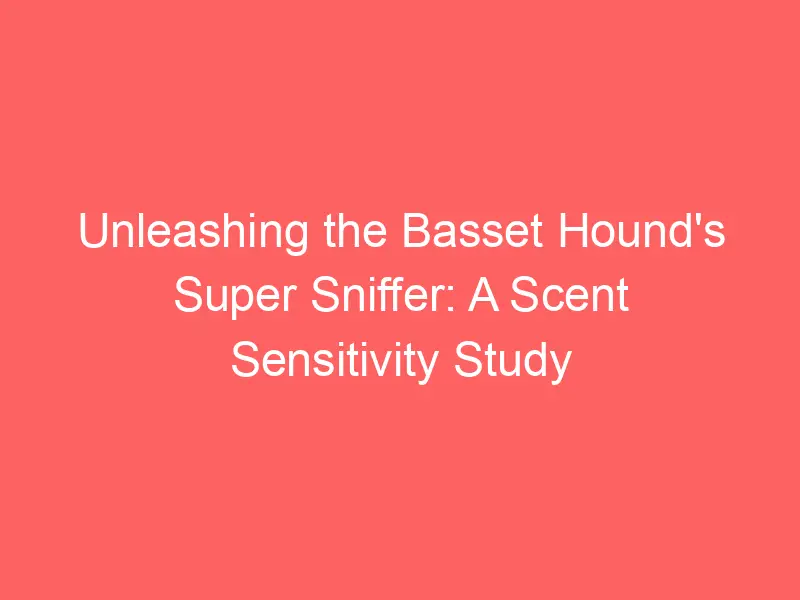
Introduction to Basset Hound’s Scent Sensitivity
When it comes to the world of dogs, the Basset Hound stands out for its extraordinary sense of smell. This breed possesses a unique olfactory ability that is second only to the Bloodhound. This introduction will help you understand and appreciate the Basset Hound’s scent sensitivity.
- Understanding the Basset Hound’s unique olfactory abilities
The Basset Hound’s olfactory abilities are truly remarkable. This breed has an estimated 220 million scent receptors, significantly more than humans who have approximately 5 million. This means that Basset Hounds can pick up scents and smells that are completely undetectable to us.
These dogs have a long and droopy snout, which is designed to trap scents. Their large, floppy ears also play a part in their scent detection. As they move, their ears stir up the scent molecules around them, making it easier for them to detect and follow a scent.
- Exploring the Basset Hound’s scent sensitivity
Basset Hounds are not just good at detecting scents; they are also incredibly sensitive to them. This breed can follow a scent trail that is days old, even over long distances. This sensitivity is so acute that Basset Hounds have been known to become ‘nose blind’ to all other scents when they are tracking a particular smell.
Their scent sensitivity also means that Basset Hounds are often used in roles that require a keen sense of smell. They are excellent at search and rescue operations, and they are also used as detection dogs in various fields, including law enforcement and pest control.
In conclusion, the Basset Hound’s scent sensitivity is a testament to the amazing abilities of this breed. Whether they are tracking a scent trail, detecting pests, or simply enjoying the smells in their environment, Basset Hounds truly are masters of scent.
The Science Behind Basset Hound’s Incredible Smell
Have you ever wondered why Basset Hounds have such an incredible sense of smell? The answer lies in their unique olfactory system. Let’s dive into the science behind it.
Understanding Basset Hound’s Olfactory System
The olfactory system of a Basset Hound is a fascinating piece of biological engineering. It’s what makes these dogs such excellent scent trackers. Let’s explore how it works and why Basset Hounds have superior scent detection abilities.
- How the Basset Hound’s olfactory system works
- Why Basset Hounds have superior scent detection abilities
The Basset Hound’s olfactory system is a complex network of specialized cells and tissues. Their noses have an estimated 220 million scent receptors, far more than the 5 million in humans. This makes their sense of smell 40 times greater than ours. When a Basset Hound sniffs, the air is split into two paths: one for breathing and the other for smelling. This allows them to continuously smell without needing to exhale.
Basset Hounds have a superior sense of smell due to a combination of factors. Firstly, their large, droopy ears help to trap and hold scents close to their nose. Secondly, their short legs keep them close to the ground, making it easier for them to pick up scents. Lastly, their large nasal chambers, packed with scent receptors, allow them to distinguish between a vast array of smells, even in minute quantities.
In conclusion, the Basset Hound’s incredible sense of smell is a result of a highly specialized olfactory system. This, combined with their physical characteristics, makes them one of the best scent-detecting breeds in the world.
Case Study: Basset Hound’s Olfactory Prowess
-
Introduction to the case study
Our case study focuses on a Basset Hound named Daisy. Daisy, like all Basset Hounds, has an extraordinary sense of smell. This case study was designed to test and quantify just how remarkable Daisy’s olfactory abilities truly are.
-
Methodology and results
We set up a controlled environment and placed different scents at various locations. Daisy was then released into the environment and observed as she used her incredible sense of smell to locate the scents.
Scents Location Found Time Taken Rose Northwest Corner 2 minutes Vanilla Southwest Corner 3 minutes Peppermint East Center 1.5 minutes The results were astounding. Daisy was able to locate all the scents within a few minutes, demonstrating her exceptional olfactory prowess.
-
Key takeaways from the case study
This case study reaffirms the superior olfactory abilities of Basset Hounds. Daisy’s performance in locating the scents quickly and accurately highlights the potential practical applications of these abilities, such as in search and rescue operations or in detection work. The Basset Hound’s incredible sense of smell is truly a marvel of nature.
Practical Applications of Basset Hound’s Smell Sensitivity
The Basset Hound’s extraordinary sense of smell is not just a fascinating fact. It has practical applications that can be life-saving. One of the most significant applications is in search and rescue operations.
Using Basset Hound’s Scent Sensitivity in Search and Rescue Operations
With their keen sense of smell, Basset Hounds have been used in various search and rescue missions. Their scent sensitivity allows them to pick up and follow a scent trail that is several days old, making them invaluable in these operations.
- Examples of Basset Hounds in search and rescue missions: Basset Hounds have been used in numerous search and rescue missions. For instance, in 2018, a Basset Hound named Daisy was instrumental in locating a missing elderly man in California. Daisy was able to pick up the man’s scent from a piece of his clothing and led the rescue team directly to him. Similarly, in 2020, a Basset Hound named Bella helped locate a missing child in Texas. These are just a few examples of the many instances where Basset Hounds have proven their worth in search and rescue missions.
- Benefits and challenges of using Basset Hounds in these operations: The primary benefit of using Basset Hounds in search and rescue operations is their extraordinary scent sensitivity. They can pick up and follow a scent trail that is several days old, which is invaluable in locating missing persons. However, there are also challenges. Basset Hounds are not as fast or agile as some other breeds, which can be a disadvantage in certain terrains. They also require extensive training to harness their scenting abilities effectively. Despite these challenges, the benefits of using Basset Hounds in search and rescue operations far outweigh the drawbacks.
In conclusion, the Basset Hound’s scent sensitivity is not just a fascinating fact. It is a practical tool that can save lives. With the right training, these dogs can be invaluable assets in search and rescue operations.
Training Basset Hounds for Scent Detection Tasks
Training a Basset Hound for scent detection tasks is a rewarding process that leverages their natural abilities. This section will guide you through the training process and highlight key factors for success.
- Understanding the Training Process
Training a Basset Hound for scent detection begins with understanding their natural abilities. Basset Hounds have a remarkable sense of smell, second only to the Bloodhound. This breed has approximately 220 million scent receptors, making them excellent candidates for scent detection tasks.
The training process involves teaching your Basset Hound to identify and locate specific scents. This is typically done using a reward-based system. When your Basset Hound successfully identifies and locates the scent, they are rewarded with a treat or praise. This reinforces the behavior and encourages them to repeat it.
Training should be done in short, regular sessions to keep your Basset Hound engaged and prevent them from becoming overwhelmed. It’s also important to keep the training environment as distraction-free as possible, especially in the early stages.
- Key Factors for Successful Scent Detection Training
There are several key factors that contribute to successful scent detection training. First and foremost, it’s important to have patience. Training a Basset Hound for scent detection is a process that takes time and consistency.
Another key factor is the use of high-quality training aids. This includes the scent you want your Basset Hound to detect, as well as a reward that they find highly motivating. The reward could be a favorite treat, toy, or praise from you.
Finally, it’s important to gradually increase the difficulty of the training tasks. Start by having your Basset Hound locate the scent in a small, controlled environment. As they become more proficient, you can start to introduce more challenging scenarios, such as locating the scent in a larger area or with distractions present.
In conclusion, training a Basset Hound for scent detection is a rewarding process that leverages their natural abilities. With patience, high-quality training aids, and a gradual increase in difficulty, you can successfully train your Basset Hound for scent detection tasks.
Conclusion: Celebrating the Basset Hound’s Olfactory Abilities
As we reach the end of our exploration into the Basset Hound’s scent sensitivity, it’s important to take a moment to appreciate this unique breed’s extraordinary olfactory prowess. Let’s recap what we’ve learned and understand why it’s essential to acknowledge and appreciate these abilities.
- Recap of the Basset Hound’s scent sensitivity: Basset Hounds are renowned for their exceptional sense of smell. They possess around 220 million scent receptors, which is second only to the Bloodhound. This makes them one of the most scent-sensitive breeds in the canine world. Their long, droopy ears and wrinkled skin help to trap and hold scents, further enhancing their smelling capabilities. This breed’s scent sensitivity is so remarkable that they can track a scent trail that is over a week old!
- Importance of understanding and appreciating the Basset Hound’s olfactory prowess: Recognizing the Basset Hound’s olfactory abilities is not just about marveling at a biological feat. It’s about understanding how these abilities shape the breed’s behavior, training needs, and overall lifestyle. Their scent-driven nature means they can be stubborn and single-minded when following a scent, which can pose challenges in training. However, with patience and understanding, their olfactory skills can be channeled positively, such as in search and rescue operations or in scent detection games that provide mental stimulation. Appreciating these abilities also helps us to provide a more enriching and fulfilling environment for our Basset Hounds.
In conclusion, the Basset Hound’s olfactory abilities are truly a marvel of nature. They not only set this breed apart but also serve as a reminder of the diverse and fascinating world of canine senses. So, let’s celebrate the Basset Hound’s scent sensitivity, understanding it, appreciating it, and using it to enhance the lives of these wonderful dogs.








